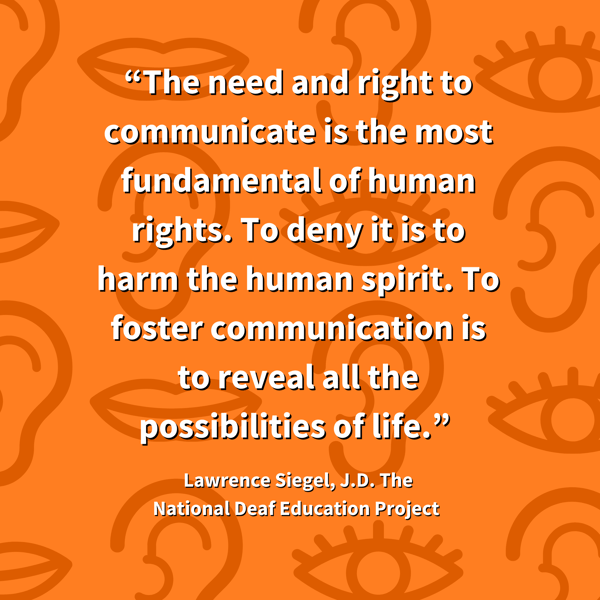In a world bombarded with sights and sounds, those who struggle to hear are often left behind. Those of you who know me understand hearing loss is something I find deeply interesting, especially hearing loss in children. More on that in a little while.
We all know that technological advances are continuing to occur at a rapid pace, but those advancements are regularly lost in our day-to-day lives. Sure, we see the advancements made in microchip technology in our cell phones or the innovation of new screen technologies in our televisions. However, sometimes it seems these advancements are lagging especially in the development of medical devices.
Yes, I can check my blood pressure, but why can’t I pay all my medical bills to only one place instead of a multitude of providers, doctors, and facilities?
Yes, I can tell how many steps I took today, but why do my knees still hurt?
And yes, we can provide more advanced machine-human interfaces, but why is the FDA approval process so tedious?
These are real-world questions that continue to torment us.
However, not all is lost. We are starting to see some advancements slowly emerge. We are watching technology gain traction in the practical aspects of everyday healthcare. For many, the recent advancement of the COVID-19 vaccine was slow. Nevertheless, in the world of vaccine development, it was light years ahead of previous processes. The introduction of virtual trials and development platforms using new DNA and RNA-based vaccines are revolutionizing the way the world responds to viruses. Recently the medical device giant Medtronic has introduced Bluetooth technology in a handheld reader that allows for smart patient monitoring for individuals with pacemakers. Each day is beginning to bring something new that is directly impacting the consumer.
True Brainpower
Enter the oldest hearing aid manufacturer in the world, Oticon. Founded in 1904, Oticon was created with a people-first approach. The founder, Hans Demant, simply wanted his hearing-impaired wife to live a better life by introducing her to one of the world’s first electronic hearing aids. Fast forward a century later and we still see a company focused on delivering technology directly to its users.
Oticon recently took the next step in hearing technology. Their basic premise is to focus on speech and not just sound. As many with hearing loss can tell you, it is not about boosting the volume. People with hearing loss suffer from clarity and comprehension because of the way they actually hear. Simply turning up the sound does not fix the problem. But what if a hearing aid could distinguish between sounds and recognize certain cues? The brain is designed to decipher sounds and it needs to make sense of those sounds. By thinking of the brain and not just the volume, Oticon has introduced a radical change in hearing aid technology with what they call BrainHearing.
In the past, aids were used to prioritize the speech happening in front of the person, and then reduce the effect of non-speech sounds also coming into the device. With BrainHearing, the device makes sounds that are more meaningful stand out and then amplifies them accordingly so the brain can pick them up.
Listening and Learning in the Cloud
By using new advancements in artificial intelligence (AI) and an embedded deep neural network (DNN), Oticon introduced its Oticon More product which allows the aid to make determinations on what sounds are important to the brain. Because it is a DNN, the sounds are processed against multiple layers to achieve the highest results. The network was trained with 12 million sounds from real environments resulting in a system that is extremely well prepared to recognize sounds that are important to the brain.
The DNN is the engine of the hearing aid and decides what sounds have the characteristics that are essential to the brain and amplifies them while reducing the non-important sounds — just like the brain of those without hearing loss. Additionally, by leveraging the Microsoft Azure cloud, Oticon collects data from the hearing aid in the cloud and uses the input to deploy general software updates that enhance the hearing experience for each user. Tests show that this, combined with Oticon’s methods of understanding sound processing, has resulted in more than 30% of sound delivered directly to the brain. Additionally, speech understanding is increased by more than 15% compared to previous models. Oticon is working to transform the hearing aid world.
The Work Isn’t Over
So where does that leave us now? We are still in the early, but rapid advancements of healthcare-related technology. Just a few years ago robotic surgery and even a telehealth visit were considered the leading edge, but today they are commonplace. While Oticon is leading the pack in hearing aid advancements, all manufacturers still have work to do. Completely waterproofing this technology or producing an aid that can truly contain musical, low-frequency sounds without enclosed earmolds is still just out of reach.

“The need and right to communicate is the most fundamental of human rights. To deny it is to harm the human spirit. To foster communication is to reveal all the possibilities of life.” Lawrence Siegel, J.D. The National Deaf Education Project
Hearing is serious business. Isolation due to hearing loss can be directly attributed to depression and dementia. Hearing aids are not volume controls, they are sensors of the sound environment. Even with all the advancements today, many children are still not being treated for hearing loss. Most families cannot pay, nor do many insurance carriers cover the cost of these devices. The benefits of early detection are available through the Centers for Disease Control and Prevention, but facts and figures only support what we already know; children who do not hear, struggle with speech development, language, and social skills. Like it or not communication is critical to human interaction. Until we collectively understand our commitments to healthcare advancements, the world will continue to miss opportunities to make significant and real changes in other people’s lives. Hearing that is aided by these new technologies is taking us in the right direction.


